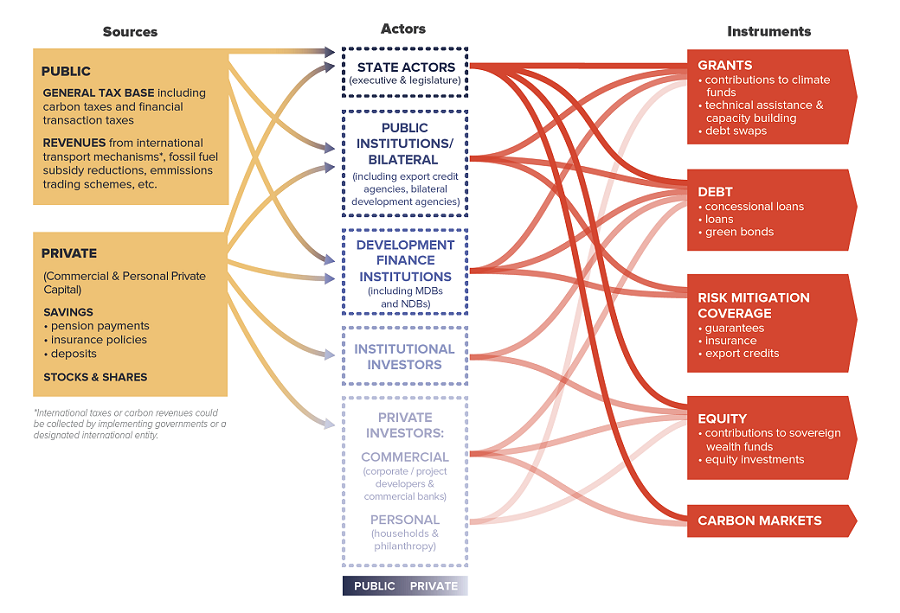Before tackling the “how-to” of financing sustainable infrastructure, this section first assesses the landscape of sources, actors and instruments of financing (see Figure 5). Section 2.2 then outlines the main barriers to shifting and scaling up the finance needed for sustainable infrastructure. Finally, section 2.3 outlines some of the solutions that are starting to take hold in some countries and sectors, which can be scaled up to deliver sustainable infrastructure investment.
This discussion is organized around the various public and private sources of finance, yet equally important is the question of whether the finance is external or domestic. For example, the majority of global capital flows targeting climate change are raised and spent within the same country (72%) at the moment, and this share rises to 92% when looking at private flows alone.1 More generally, for all infrastructure investment in developing countries, domestic resources far outweigh external development finance.2As such, domestic sources of capital, both public and private, remain particularly important for sustainable infrastructure investment, which in turn highlights the need to get domestic policies right. External finance – both public and private – will also feature and can in particular help catalyse domestic investment. However, as it is largely a domestic challenge, financing sustainable infrastructure requires domestic leadership and bold policy reforms to take the agenda forward.
Sources of infrastructure finance

Public finance and funding
Public resources from national budgets have historically been a major source of funds and finance for infrastructure investments, and will remain so in the future, particularly for assets that deliver public goods. National budgets include the use of revenues that countries raise themselves, in particular through taxes, or other finance they are able to raise, for example through bonds and loans or, in some cases, funding provided through development finance institutions. In developing and emerging economies, 60–65% of the cost of infrastructure projects is financed by public resources,4although the total amount of public investments is often constrained due to inadequate fiscal revenues, given often low rates of taxation and challenges with tax collection, and limited access to debt financing. In advanced economies, public resources contribute about 40% of the total, an amount that has shrunk largely as a result of the global economic crisis.
Lately, subnational and local governments have been raising revenue finances of their own and have, in a number of instances, successfully issued infrastructure or green bonds. In this arena the main actors are typically those in the public sector, i.e. public corporations or state or municipal utilities. Public revenues may also be used to fund private concessions as infrastructure operators or other private entities – for example, using procurement mechanisms or public-private partnerships (PPPs).
The effectiveness of domestic funds is also critical to ensure that more positive impact can be achieved with the resources available. Auctioning for public procurement has emerged as a good example of how to improve efficiency in using limited public resources for sustainable infrastructure investment. For example see the Renewable Energy Independent Power Producer Procurement Programme in South Africa (Box 20).
